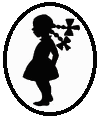

We do not know a great deal about girls' clothing in Scotland. We do know that until after the mid-20th century Scottish girls like girls in other countries mostly wore dresses. we are unsure how popular skirts were. We do see pinzrirs un the 19th century. They were very popular in the late-19h century and very early-20th century. As far as we know styles were identical to those worn in England. This of course was surely the case in the Lowlands, the area of Scotland heavuly influenced by England. We believe there were differences in the 18th century, but this declined in the 19th cernyury. And we are not aware of makor differences in the 20th century. There were of course plaid dresses and skirts. But these were also worn in Englland, we are unsure about chrionological trends, although we suspect thast they were sugificant in the 18th century. Presumably they were more popular in Scotland than in England, but the photographic record shows that plaid was popular in both England and Scotland. Of course photographs only appear in numbers during the mid-19th century. There does not seem to be anything comparble to boys Highland kilt outfits. This was one reason tht Aboyne outfits were created. There are two different styles, but this is a fairly modern creation and only worn for dance competitions. Unlike the similar dirdl fashion in Germany, it is not a style commonly worn even for folk celebrations. We only see it bing worn by Higland dancers. We have begun to collect information on girls dresses, but at this time see no real difference between England and Scotland.
We do not know a great deal about girls' clothing in Scotland. Our Scottish archive is limited which limits our ability to assess fashion trends. We have, however, begun to add some images.
Scottish girls almost entirely wore skirted garments until the mid-20th century. This was the common convention throughout Europe. We do know that until after the mid-20th century Scottish girls like girls in other countries mostly wore dresses. There were of course counless styles and decoative touches. We are unsure how popular skirts were. We do not see many skirts in the photographic record, but this may be because most girls dressed up for studio portraits which constituted the great bulk of the photographic record throughout the 19th century. We see very few snapshots until the 20th century. We do see pinafores in the 19th century and they were probably much more common than suggested by the photographjioc record. Again this probably reflects the tendency to dress up for a studio portraits. Meaning most girls wwe nowear pinafiores fir the portrait, even though they commonly wore them. Dresses were very common in the late-19h century and very early-20th century.
We have begun to collect information on girls clothing, but at this time see no real difference between girls clothing in England and Scotland. There were differences earlier. And it should not be thought that it was only Engklish fashions influencing Scotland. As a young girl, Princes Victoria as entralled with Scottish literature. She brought this love of Scotland with her when sghe became queen (1837). Queen Victoria's love of Scotland helped fuel interest onr Scottish styles among the English.
As far as we know styles were identical to those worn in England. This of course was surely the case in the Lowlands, the area of Scotland heavuly influenced by England. We believe there were differences in the 18th century, but this declined in the 19th cernyury. And we are not aware of makor differences in the 20th century.
Scotland is if course best known gor plaid/tartan. There were of course plaid dresses and skirts. But these were also worn in Englland, we are unsure about chrionological trends, although we suspect thast they were sugificant in the 18th century. Presumably they were more popular in Scotland than in England, but the photographic record shows that plaid was popular in both England and Scotland. Of course photographs only appear in numbers during the mid-19th century.
There does not seem to be anything comparble to boys Highland kilt outfits. This was one reason tht Aboyne outfits were created. There are two different styles, but this is a fairly modern creation and primarily worn for dance competitions. Unlike the similar dindl fashion guirls in Germany wore, it is not a style commonly worn even for folk celebrations. We only see it being worn by Higland dancers.
Navigate the Boys' Historical Clothing Web Site:
[Return to the Main girls European country page]
[Return to the Main girls country page]
[Return to the Main girls page]
[Return to the Main Scottish page]
[About Us]
[Activities]
[Biographies]
[Chronology]
[Color]
[Countries]
[Difficult images]
[Families]
[Garments]
[Gender conventions]
[Hair]
[Literature]
[Photo intrpretation]
[School]
[Sisters]
[Return to the Historical Girls Clothing Home Site]
